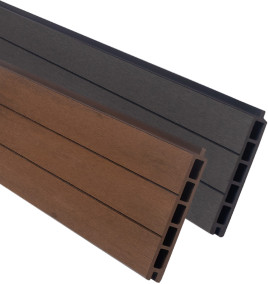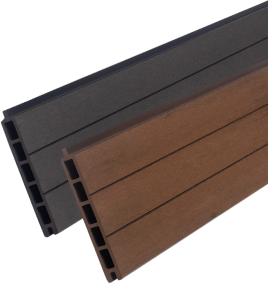 Previous Article
Previous Article
The Ultimate Guide to Decking Ideas (2025 Edition)


Composite fencing is fast growing in popularity with homeowners here in the UK, and for good reason. It’s a modern enhancement to traditional timber fence panels, offering huge benefits and advantages that are seen as an investment that pays you back over time.
Of course, personal preference always plays a part. If you’ve just come across composite fencing, you may be asking: “Why should I choose this over traditional wood?”
You’re in the right place. Let’s compare them on the key factors—from maintenance and durability to the true long-term cost—to give you the information you need to make the right decision.
| Feature | Wood Fencing | Composite Fencing |
|---|---|---|

|

|

|
| Maintenance | High (Annual sealing & painting) | Very Low (Simple cleaning only) |
| Average Lifespan | 10-15 Years | 20-30+ Years |
| Long-Term Cost | Becomes more expensive over time | Higher initial cost, but cheaper long-term |
| Look & Feel | Classic, rustic look | Modern, premium, and customisable |
| Winner | Best for very low budgets or short-term needs. | Best for long-term value, performance, and looks. |
Any outdoor product needs maintaining against the elements, but the key question is: to what level?
| Material | Maintenance Level |
|---|---|
| Wood | High Maintenance: Requires annual sealing and regular painting/staining to prevent rot. |
|
Composite Fencing
|
Low: Requires simple cleaning only. No painting or sealing is ever needed. |
The issues with timber fencing are well known. To make it last, it needs constant maintenance. As a general rule, a timber fence needs to be sealed once a year and painted every 3-5 years to retain its strength and visual appeal.
Composite fencing, on the other hand, is extremely moisture-resistant. Because of this, it never needs to be sealed, painted, or stained to retain its strength and look. Simple hot, soapy water once or twice a season is all that’s needed to keep it looking great.
| Material | Strength (Year 1) | Strength (Year 1) |
|---|---|---|
| Wood | Good | Poor (Significantly weakens over time) |
| Composite Fencing | Excellent | Excellent (Maintains most of its original strength) |
When it comes to durability, composite again outperforms wood. The real test comes over time. If you gave a wooden fence the same low level of maintenance as a composite one, the difference would become clear in as little as 5 years.
Composite outperforms wood in two key areas. Firstly, the shorter lifespan of wood leads to more waste. Secondly, the chemicals used in pressure-treated timber make it difficult to recycle.
| Materials | Environmental Impact |
|---|---|
| Wood | Often chemically treated; shorter lifespan leads to more waste. |
|
Composite Fencing
|
Gives new life to up to 90% recycled materials; long lifespan reduces waste. |
Composite fencing has a much longer lifespan and has a huge positive impact by reducing the amount of plastic waste that would normally end up in landfill.
While traditional timber has a classic appeal, it can be rustic and raw in appearance. Modern composite panels are continually being improved.
Innovations like our natural slatted fence panels now capture the unique wood grain patterns seen in premium timber, with mixed colours and an array of design options. For the first time, composite technology can bring the authenticity of natural hardwood into a fence panel, while also offering clean, contemporary designs.
| Materials | Natural Apperance |
|---|---|
| Wood | Good Appearance: A classic, natural look. |
|
Composite Fencing
|
Natural Appearance: Can provide a highly realistic hardwood appearance, or a clean, modern look. |
Colour stability is a critical factor in the long-lasting visual appeal of your garden design.
Wood fades very quickly. A common complaint is that a brown fence turns grey within a couple of years. Composite fencing retains its colour far better. While it may lighten slightly, the base colour remains, retaining its visual appeal for years.
| Materials | Fading |
|---|---|
| Wood | Aggressive Fading: Quickly weathers and turns a dull, silvery-grey. |
|
Composite Fencing
|
Enhanced Stability: Capped boards have minimal fade; uncapped boards lighten but retain their base colour. |
Composite fencing is an investment, so let’s look at the total cost of ownership. For this comparison, we’ll look at replacing 10 fence panels in a garden with existing concrete posts.
Key takeaway: While wood has a lower initial cost, the ongoing maintenance costs in both time and materials mean that composite becomes the more cost-effective option over the long term.
Assumptions used:
Now, let’s review the total cost for installing different types of our composite fencing.
| Cost Over Time | Wood Fencing | Uncapped Composite Fencing |
|---|---|---|
| Initial Cost (Materials + Labour) | £520 | £1,200 |
| Est. Total Cost After 5 Years | £520 + £252 (maintenance) = £772 | £1,200 + £80 (cleaning) = £1,280 |
| Est. Total Cost After 10 Years | £772 + £336 (maintenance) = £1,108 | £1,280 + £80 (cleaning) = £1,360 |
| Est. Total Cost After 15 Years | £1,108 + £84 (maintenance) + £520 (replacement) = £1,712 | £1,360 + £80 (cleaning) = £1,440 |
The break-even point occurs around year 12-13. After this, and especially after factoring in the cost of replacing the timber fence, composite fencing delivers a clear return on investment.
Composite fencing does have a higher upfront cost, but when you review all the key points, it comes out on top. It offers a consistent, modern garden look that elevates your home’s kerb appeal, and the investment pays you back over time not just in appearance, but in your pocket too.
 Previous Article
Previous Article
The Ultimate Guide to Decking Ideas (2025 Edition)

A Buyer's Guide to Composite Fencing Kits (2025)